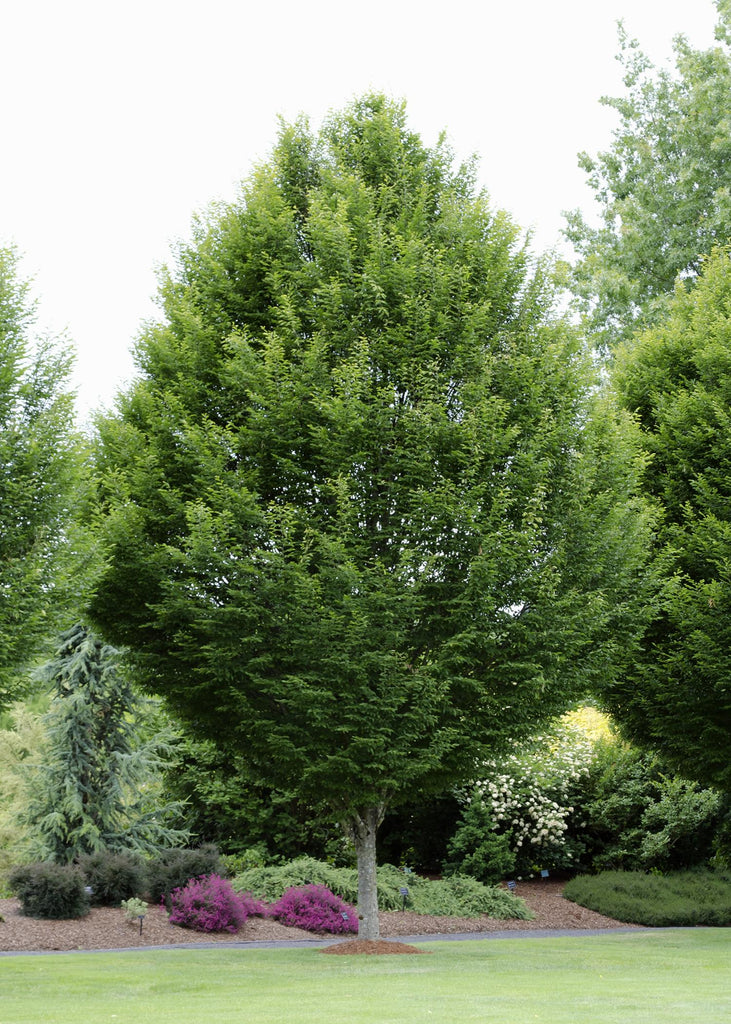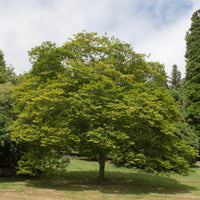




Couldn't load pickup availability
Ships in
November 2025Hornbeam Trees for Sale | Carpinus betulus
The Hornbeam Tree (Carpinus betulus) is a hardy and deciduous tree native to Europe. It is a beloved tree with distinctive, gray bark that is lightly ridged and smooth.
Plant Details - Hornbeam Tree
Family: Betulaceae
Light Requirement: Full Sun
Water Needs: Moist
Height: 40 – 60 ft.
Spread: 40 – 60 ft.
Growth Rate: Slow
Bloom Time: Spring
Flower Color: Yellow
Wildlife Value: Attracts butterflies
The Hornbeam Tree is a hardy and beautiful deciduous oval shaped tree that will make a great visual impact in your yard or landscape. This tree can be planted in an area with full sun or partial shade. This is an excellent option for planting as an ornamental accent or focal point. Create a windbreak or living privacy hedge with this tree.
Plant this tree in moist and well draining soil. It can handle different soil conditions, including loamy or sandy soils. It will tolerate alkaline or dry soils. Water this tree regularly until it is well established. You should water this tree during the heat of summer when drought occurs. Its dark green, deeply veined, and doubly serrated leaves will turn a beautiful shade of yellow in the fall. This tree will create plenty of shade as it grows that is suitable for growing a shade garden underneath. This tree produces two kinds of catkins that will emerge in early spring. Male catkins are yellow. Female catkins are green and turn into papery samaras. This tree produces small brown nuts that birds and small mammals will enjoy eating. This tree does not have any major disease problems. You can add mulch or compost around the base of the tree, but be sure to give plenty of space to keep the trunk dry. Watch this tree for signs of stress and cut off any damaged or diseased branches. Deer resistant. Protect it while it is young and vulnerable to browsing damage. Hornbeam Tree will attract lots of wildlife to your yard or landscape. Birds will use its branches to make their nests.Landscape Uses and Maintenance for Hornbeam Trees
Noteworthy Characteristics of Hornbeam Trees
This Is How Your Plants Will Look upon Delivery

Height at Maturity
Over 25 Feet
Care
Hornbeam trees thrive in well-drained soil and benefit from regular watering, especially during dry periods. They should be pruned in late winter to preserve form and release dead or diseased branches. It is recommended that they be fertilized annually in early spring to encourage healthy growth.
Plant Reproduction
Hornbeam tree spreads via seeds and suckers, forming dense clusters
How to Grow and Care for Bare Root Trees
Bare root trees are shipped dormant without soil, making them lightweight, cost-effective, and easy to plant during the cool months of early spring or fall. To begin, soak the roots in a bucket of water for 4–6 hours before planting to rehydrate them. Choose a sunny location with well-draining soil and ample space for the tree’s mature size.
Dig a hole twice as wide as the spread of the roots and deep enough to keep the root flare (where the roots begin to spread from the trunk) at or slightly above ground level. Create a small mound of soil in the center of the hole, spread the roots evenly over it, backfill with native soil, and gently tamp down to remove air pockets. Water thoroughly after planting.
Keep the soil consistently moist (not soggy) during the first growing season, and apply mulch around the base—avoiding direct contact with the trunk—to conserve moisture and suppress weeds. Stake the tree if necessary, and prune only to remove dead or damaged branches. With proper care, your bare root tree will establish quickly and grow strong for years to come.
We carefully package every plant to retain superior moisture during transit. Once prepared, orders ship the same day through UPS or USPS, with typical delivery in 2–4 days.
Returns are not accepted, but plants are reshipped if extended warranty insurance was purchased at checkout. Otherwise, all plants include a standard 5-day warranty after delivery.




Caring Tips
How do I care for my Hornbeam Tree?
Each box contains detailed care instructions and information about your product. But here's the basics.
Care Tips
Hornbeam trees thrive in well-drained soil and benefit from regular watering, especially during dry periods. They should be pruned in late winter to preserve form and release dead or diseased branches. It is recommended that they be fertilized annually in early spring to encourage healthy growth.
Light Requirements
The Hornbeam tree grows best in full sun to partial shade. It can tolerate various light conditions but grows most vigorously and maintains its best form in complete sun, obtaining at least six hours of direct sunlight daily.
Hardy Planting Zones
3 • 4 • 5 • 6 • 7 • 8 • 9
This Hornbeam Tree is a landscape designer’s dream. TN Nursery sent a tree that was healthy and ready to thrive. Its dense foliage and upright habit make it ideal for hedging or as a stand-alone feature. Excellent value and service.
I’ve planted my Hornbeam Tree in a suburban yard, and it’s doing great. It tolerates compact soil and partial shade really well. TN Nursery delivered a quality specimen that adapted quickly. I highly recommend this tree for structured designs.
The Hornbeam Tree I received from TN Nursery was already budding when it arrived! It’s growing quickly and looks fantastic in my landscape. A great option for anyone seeking a dependable, hardy tree with visual appeal.
I purchased a Hornbeam Tree from TN Nursery and couldn’t be happier. It’s a low-maintenance tree with a stunning shape and dense foliage. The planting process was easy thanks to the detailed care instructions included.
TN Nursery delivered a beautiful Hornbeam Tree that has exceeded my expectations. It has a strong trunk, deep green leaves, and is thriving in my soil. This tree is perfect for creating a classic, well-organized landscape.
